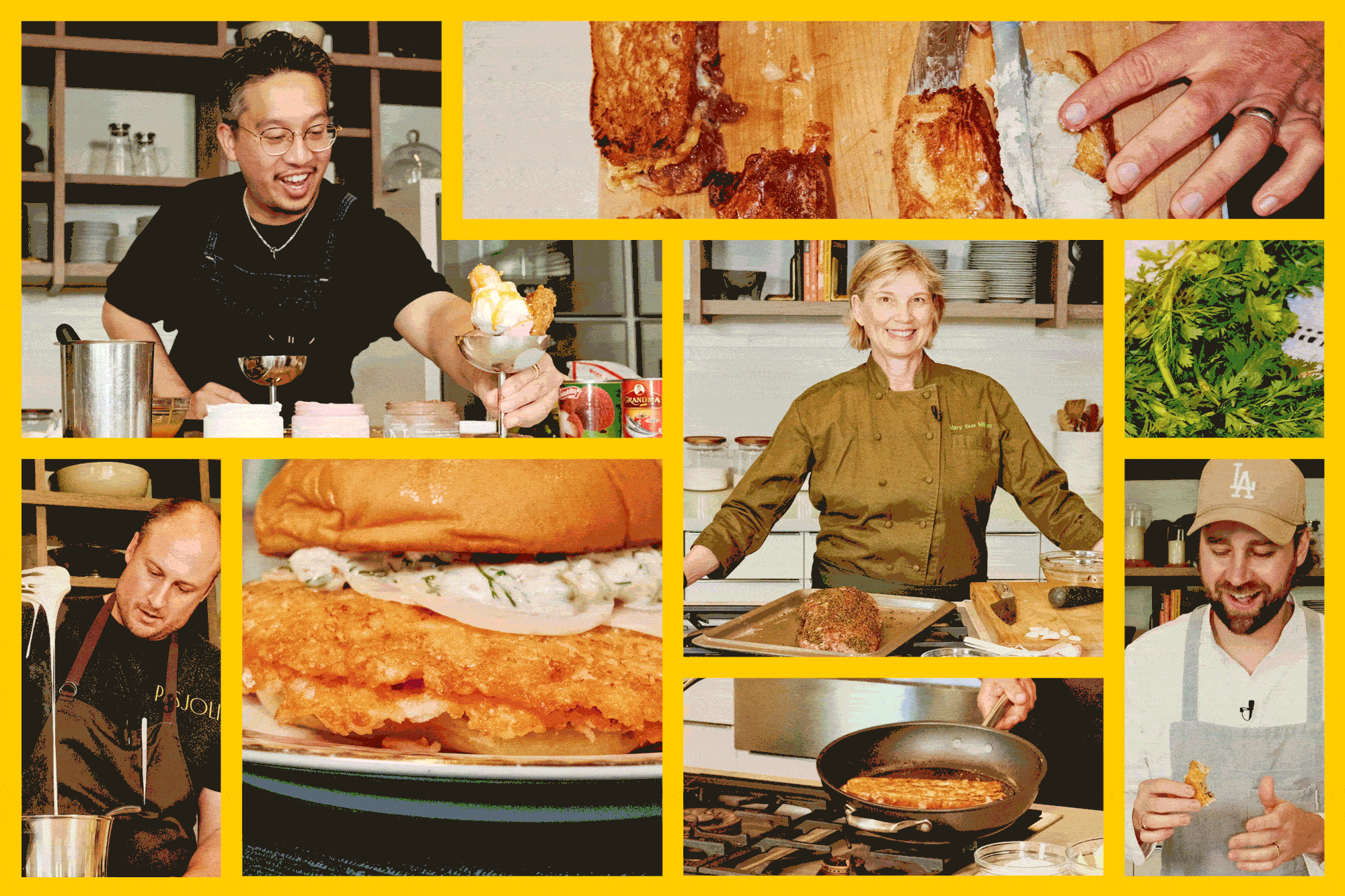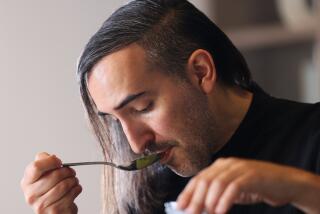FRESH FROM THE LAB
SAN DIEGO — A low-slung, ‘50s-era office complex in the middle of a commercial park in San Diego doesn’t look much like a hotbed of progressive cuisine.
But here in Food Lab 1 at a company called CP Kelco, food scientist Ted Russin is doing his part to spark the imaginations of chefs.
Russin is holding a blowtorch to a disk of what looks like lemon-yellow Jell-O, except that it’s made with gellan gum instead of gelatin. He keeps blasting away at it, in the interest of demonstrating its heat-resistant properties (gellan gum is produced by bacteria discovered on a lily pad in Pennsylvania in the 1970s).
“If you’ve ever blowtorched gelatin, it’s a horrible, horrible thing,” he says. But the gel in his pan looks generally unfazed; the sugar is starting to caramelize, but the disk is otherwise holding its shape.
“It can withstand deep-frying. You can serve warm gelees,” he says. Or, as Fat Duck chef Heston Blumenthal uses it, you can make sorbet and ice cream that don’t immediately melt when flambeed.
That’s the magic of hydrocolloids, substances that can thicken liquids or turn them into gels. They hold a special interest for chefs who are looking for ways to present familiar flavors in new forms, the crux of cutting-edge cooking. CP Kelco makes hydrocolloids such as pectin, carrageenan, gellan gum, cellulose gum and xanthan gum. “Our expertise is texture modification, anywhere where you need to control water,” Russin says. “There’s a lot of water in food, a heck of a lot of water.”
Familiar pantry items such as starch and gelatin are hydrocolloids, as are agar and pectin.
--
Keeping it together
Hydrocolloids are what prevent bottled salad dressings from separating into water and oil. And they’re staples in many high-end chefs’ repertoires, whether they want to tie foie gras into knots or make smoother, silkier sauces.
But encapsulating liquid in a gel exterior or making sure the gellan coating for one’s fish has a desirable texture requires understanding some of the science behind these ingredients.
“It’s like being a choreographer,” says Russin, who has studied ballet. “You have to have a certain amount of technique before you can create a dance.”
Chefs such as Thomas Keller and Corey Lee of the French Laundry and Kyle Connaughton, research chef at the Fat Duck, have tapped Russin to help hammer out ideas, perfect methods or discuss the science of cooking in general. “He has been a great resource for us in understanding these ingredients,” says Lee, who has visited the lab in San Diego. “He has worked on several experiments with us so it’s not just trial and error. There’s an approach to ingredients where we’re not just throwing darts here.”
In Keller’s latest book, “Under Pressure: Cooking Sous Vide,” gellan gum is an ingredient in a recipe for a mango “yolk,” a sphere that has a gel exterior surrounding mango juice. He credits CP Kelco with helping to develop the recipe, which involves dropping spoonfuls of mango juice mixed with gellan gum and sodium hexametaphosphate (used to keep the mixture from setting right away) into a bath of water containing calcium gluconate, which sets the gel.
This is the technique behind Ferran Adria’s “liquid olives,” though he uses different hydrocolloids.
Most of CP Kelco’s business is with major food manufacturing companies that make sauces by the vat, but Russin says working directly with high-end chefs gives him a chance to bridge the gap between the culinary arts and food science -- “to straddle the divide between these two related yet somewhat distant disciplines and create new food ideas from this collaboration.”
The ‘50s and ‘60s were the golden age of food science, Russin says. “Frozen dinners were a huge leap.” Another big innovation in food was laminated packaging, he says. “And Cool Whip is extraordinary,” from a food science perspective. Who knows whether chefs deep-frying mayonnaise and making drinks that are simultaneously hot and cold could spur the next transcendent leap?
“I’m assuming this is kind of how haute couture works,” Russin says. What starts in cutting-edge restaurants may inspire what ends up in the aisles of the supermarket. “I’m somewhere in the middle. It’s a very exciting place to be.”
Russin, 34, wears a knee-length white lab coat; two Sharpies and a digital timer are tucked into his pocket. He looks boyish and wears glasses, and the crown of his brown hair is styled into a short peak that intimates irreverence (after all, he was a member of a metal band called Shrifft and has on at least one occasion taken his two-wheel-drive Neon off-roading in the desert east of San Diego).
Growing up in Winnipeg, Canada, he showed early signs of taking up a career in food science. He recalls asking a teacher how to make Kool-Aid properly. “It turns out there is a right answer,” he says. (You first mix the Kool-Aid with sugar and then stir the mixture into water.)
--
A new career path
He has a bachelor’s degree in philosophy, a cooking certificate (he was briefly chef de partie at a French restaurant in Winnipeg), and a master’s in food science and agricultural chemistry. He set out to be a philosophy professor and planned to work his way through graduate school by cooking, but says he had an “existential crisis” (he was reading Kierkegaard at the time) when told that academic job prospects were slim. “I spent every day for two months in the career center.” Seminal experiments in cake baking for a junior high school science project helped solidify his decision to pursue a career in food science.
He started working at CP Kelco in early 2006. That wasn’t long after technical support representative Amy Wong received a phone call from sales representative Fany Setiyo of Le Sanctuaire, a supplier of ingredients to chefs. Setiyo was trying to source a certain type of pectin on behalf of chef Ludovic Lefebvre, who was preparing for an appearance on “Iron Chef,” and Wong overnighted some samples to New York.
Chefs from across the country were calling to ask for samples of the stuff CP Kelco sells to its food-manufacturing clients by the truckload. “We were spending a lot of time fielding calls,” Wong says. A partnership was struck between CP Kelco and Le Sanctuaire, now the exclusive distributor of its products to chefs.
“When we first started carrying this stuff, everybody thought we were crazy,” Setiyo says. “It was risky. What if it doesn’t sell?” Le Sanctuaire (which has a San Francisco showroom and online store), now carries about 30 types of hydrocolloids from various producers.
“We knew what was going on with chefs was really interesting,” says Wong, who along with Russin and Henri Monty, then director of innovations for the Americas, turned into a sort of culinary outreach team. “It’s Ted who gives so much of his own time.”
In the lab, Russin formulates salad dressings and comes up with products such as a foam for coffee that can be squirted out of a can and a self-layering dessert for which CP Kelco has submitted a patent application. He also has helped chefs in their kitchens and delivered lectures to enthusiasts, food professionals and students at the Culinary Institute of America in Hyde Park, N.Y., and at Greystone in Napa, Calif., on topics such as “Hydrocolloids: An Overview and Toolbox” and “Different Kinds of Thick.”
Russin is writing a chapter for a planned Culinary Institute text, “Introduction to Culinary Arts and Sciences,” in which he covers physics and chemistry in the kitchen. And he is contributing to a forthcoming book about the techniques of modern cuisine by Chris Young, former manager of food research at the Fat Duck, and Nathan Myrhvold, former Microsoft chief technology officer.
--
Art of the possible
Russin tends to talk about desserts as “systems” and discusses cooking in terms of heuristic techniques but also has the rare ability to convey complicated concepts to laypeople. “Sometimes he’ll go off on something, and I’ll say, ‘Ted, break it down to me in 10 words or less,’ and he does,” says Adrian Vasquez, pastry chef at Providence in Los Angeles. “Ted in my book is a genius.”
When Russin stops by El Bizcocho, the restaurant at the Rancho Bernardo Inn in Escondido, he is treated like a minor celebrity. “I couldn’t believe it when I found out that these guys were right here in our own backyard,” executive chef Judd Canepari says.
Russin pulls out his laptop and opens a spreadsheet that shows the iterations of an experiment he’d worked on with chef de cuisine Steven Rojas. “Chefs make fun of me for this and then beg me to send it to them over e-mail,” Russin says.
Rojas is making a rum-and-coke gel with gellan gum that he carbonates in a CO2 canister. He has been making it with 1% gellan gum. “That’s really high. Do you know the brix?” Russin asks, referring to the dissolved solids-to-water ratio.
Another of Rojas’ desserts comes to the table with a small glass container of watermelon gel. A server picks up the container, shakes it and the gel becomes a liquid, to be poured around compressed frozen watermelon and sorbet.
“I am constantly surprised by chefs’ creativity,” Russin says. “I had [WD-50 chef Wylie Dufresne’s] deep-fried hollandaise and before tasting it I thought, ‘I don’t know why you would do that.’ But it was tasty, unctuous, with a nice crust on the outside.”
A lot of chefs are really having fun with it, he says. It’s progress.
“What is possible?” Russin says. “That’s where the conversation begins.”
--
--
latimes.com /DailyDish
Creative genius
More images of the mad food scientists at work.
More to Read
Eat your way across L.A.
Get our weekly Tasting Notes newsletter for reviews, news and more.
You may occasionally receive promotional content from the Los Angeles Times.











